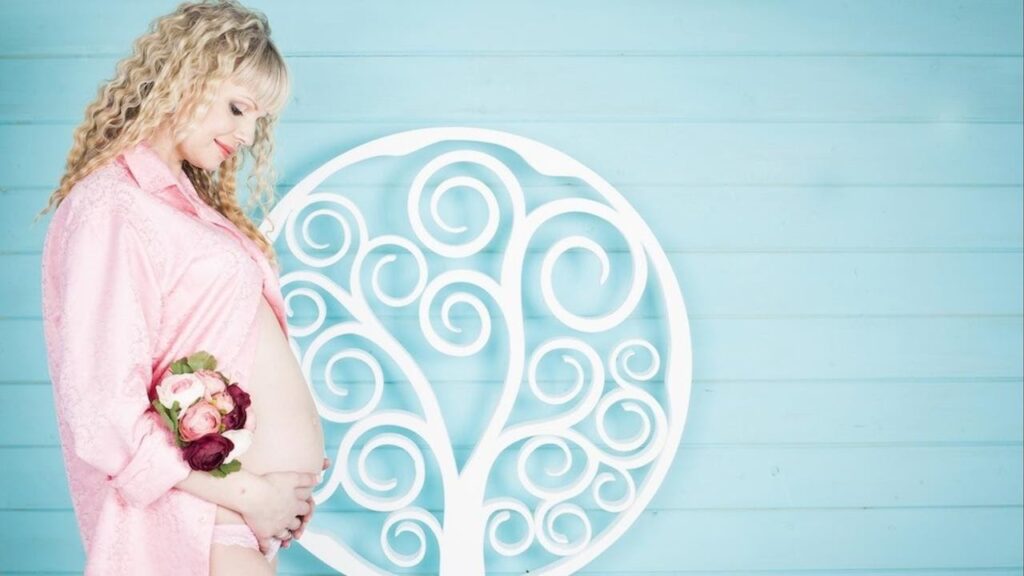Is it possible that breathing can impact the position and movement of a developing baby? The answer is YES. Inside our “core” there is an abdominal cylinder that helps us regulate our internal pressure. If that pressure becomes too great in one or more directions, weakness or pain can occur. For example, if we are lacking normal spinal motion, we set our abdominal muscles up to be in an over lengthened position. This can lead to increased round ligament pain, which can feel like a deep, sharp stretching sensation that begins or worsens with movement.
Read more on Round Ligament HERE.
Eventually, this over-lengthened abdominal position can lead to the separation of the abdominal wall also known as diastasis recti. Without the management of our internal pressure, as the baby begins to grow, a mother is likely to become inflexible in the lower back, which can lead to sciatica, hip pain, pain with sex or even prolapse. This article is not meant to be a scare tactic, instead, it is intended to educate moms on prevention during pregnancy. In fact, all of the symptoms mentioned are treatable and more importantly preventable. It is absolutely not normal to feel excess tension within your body.
Pressure isn’t the problem…
The abdominal pressure is not the problem, in fact, a baby needs the pressure to continue to grow and a mother needs that natural pressure to allow the baby to drop down into the pelvis when the time is right.
Without adequate pressure, we lose the ability to generate any strength or stability within our body. It is when we lose the ability to stabilize and keep our diaphragms “stacked” that we create tension and too much work for our hips, back, and pelvic floor.
More than one diaphragm??
As the baby continues to grow and the mother’s body changes, she is forced to find a “new” form of balance. A “balanced body” should be described still as the cylinder (even with the growing baby).
It is when our respiratory diaphragm (breathing muscle) is stacked directly above our pelvic diaphragm (pelvic floor) that we can become optimally balanced.
We can refer to the pelvic floor as a diaphragm because it acts one and the same as the respiratory diaphragm. There is a natural opposite dance that is completed between the two with every breath. It is when these diaphragms are adequately stacked that you can be successful with making it to full term and feel comfortable all the way until your due date.
Our internal pressures are constantly changing when we are moving or exercising or just breathing. Our main breathing muscle responsible for the changing pressure is the diaphragm, a domed-shaped muscle that lives under the ribcage. As we take a breath IN, the diaphragm flattens out and sends a natural downward pressure moving our intestines, stomach and bladder toward our pelvic floor. At the same time, our abdominals tighten, pelvic floor lengthens. This naturally happens about 20,000 times a day at rest.
As the baby continues to take up space, that normal internal pressure can increase the demand on your joints, pelvic floor, and lower back. In order to create more room, a woman’s body begins to change.
But what is the ideal position?
Ideally, the diaphragm should work with your hamstrings to help stabilize your pelvis. With a balanced pelvis and breathing awareness, your body can become ideally “stacked” with its diaphragms.
Alternatively, if a mother allows her body to passively “fall” forward and widens her hips, she loses the ability to manage that internal pressure her body is now faced with excessive downward pressure. Again, this places too much stress on her bowels and bladder, weakens the pelvic floor, and puts more stress on the lower back and hips.
When we really get into trouble…
If the pelvic floor is damaged, if we have had a previous back, hip or spine injury or even if we carry a lot of stress in our lives, our body then begins to alter its natural movement mechanics. We then begin to lose the ability to manage our internal “pressure.” In other words, our body has to work harder than it is designed to work.
A woman runs into a problem with her pregnant body when we do not have the following:
Adequate motion in the lower back
Appropriate rib mobility
An ability to diaphragm breathe vs. belly breathe
Recent or older trauma to the pelvic floor
Habits that feed into our dominant biased body.
You must fight to find YOUR balance…
Naturally, our bodies will find the path of least resistance every time. The body is affected by the natural cascade of effects from the asymmetrical diaphragm attachments, kinetic chain musculature, and a variety of breathing patterns that will allow the body to compensate in ways that will compromise the internal “cylinder.” In other words, it is easier to be in autopilot than to be intentional. Watch to this video.
“You cannot get rid of the default “autopilot” mode until you actually spot the error”
Reset your mind and begin to change your body
In order for the core to work efficiently, we should first begin to understand that your muscles need to be able to BOTH contract and relax. We can set your body up for success by finding the optimal position for your lower back, hips and pelvic floor, so they can coordinate appropriately with each breath.
Why do I need to re-learn how to breathe?
If we breathe 20,000 times a day, shouldn’t we be good at it? Well, if you take away ALL stress in your life it might be possible. But our body has a natural tendency to avoid tension, pain and find the path of least resistance. This sounds great in theory, but ultimately avoiding balance to your system can exponentially increase the amount of pain in your body.
Imagine having the ability to fully maximize your body position, decrease the demand on your pelvic floor and improve your ability to literally push out the baby. By developing good habits early on and throughout your pregnancy, you can become embodied with the control. Wow, wouldn’t that be powerful?
When the stress placed on your body is relieved and removed, you are then able to relearn how to “stack” your diaphragms.
Once you do that:
Mama feels happy
Baby feels comfortable
Your ability to naturally down-regulate your system becomes possible.
As a movement therapist, mother and a working business owner, I can tell you I have had a good amount of stress placed on my body. With the right mindset, awareness, and dedication I was able to optimize my own body and have become an expert on the pregnant and postpartum body. I focus on identifying patterns and assist with unlocking the woman’s body so the mechanical stress can be removed and you are able to move more freely.
**Remember, you know more than you realize. Sometimes it is just the increased awareness that can break through the surface tension that will give you some relief.**

Dr. Deanna Elliott, DPT
Owner and Physical Therapist at Centered Physical Therapy, Dr. Elliott graduated with her Doctorate of Physical Therapy from Western University of Health Sciences in 2011 and received her bachelor’s degree in Kinesiology at Sonoma State in 2008. She has been utilizing a hands-on approach to help her clients since 2011.
It was in 2018 when she got the courage to open her own practice in Grants Pass. This is where she integrates a Postural Restoration Institute® approach, which is centered around utilizing the diaphragm to help re-pattern your posture and address the body’s pain globally. She personally has struggled with my own aches and pains that left her frustrated with her own body’s limitations.
She furthered her education in order to provide a Functional Medicine approach to her clients through a licensed program with the Institute for Functional Medicine. This approach allows Deanna to address the root cause issues her clients struggle with and fine-tune their gut health. Deanna loves working with postpartum women, as she has struggled and recovered from her own physical and health issues after her 2 young daughters.










